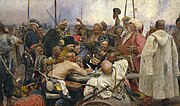Malorossian Cossacks

| Part of a series on |
| Cossacks |
|---|
 |
| Cossack hosts |
| Other Cossack groups |
| History |
| Notable Cossacks |
| Cossack terms |
| Cossack folklore |
The Malorossian Cossacks (Ukrainian: Малоросійські козаки Russian: Малороссийские казаки — literally means “Little Russian Cossacks”) were hostless Cossacks who lived primarily in the Chernigov and Poltava governorates of the Russian Empire from 1782 to 1917, following the liquidation of the administrative system of the Hetmanate in 1782.[2][3]
Background
After the liquidation of the Hetmanate in 1764, and its administrative system in 1782 by the Russian Empire, the Russian senate issued a decree under the terms of which Registered Cossacks would join the cossack social estate, allowing them to retain personal freedom, right to buy and sell land, and the right to attempt to prove noble origin in the future.[4] In order for one to prove cossack origin, one had to provide evidence of their ancestors being in the cossack register, in the absence of which witness testimony from other cossacks or nobles was accepted.[3][4]
Lifestyle and Economic Standing
Unlike other Cossack groups, the Malorossian cossacks did not have a host, as a result they did not have as many obligations and privileges as other cossacks. The Government of the Russian Empire was at odds with itself over what to do with the Malorossian Cossacks. On the one hand, assimulating them into the social estate of state peasants was desirable economically. On the other hand, letting them remain their own separate estate would be useful due to their military tradition. By the mid 19th century, their social estate was de facto absorbed into the estate of state peasants with a series of privileges such as wine selling and private land ownership, as well as different recruitment standards.[5] The Malorossian Cossacks also could relocate to join a cossack host with relative ease.[3] As a general rule, they were economically better off than state peasants or serfs and their descendants until the end of their existence.[6]
Military Formations
Following the liquidation of the Hetmanate, the Russian Empire mobilized the Cossacks into cavalry units on several occasions: in 1783, 1787, 1812, 1834, 1855, and 1863. Typically, the Russian Empire disbanded these regiments after a few years.
List of Malorossian Cossack Regiments
1783-84:
- Glukhovsky Light Cavalry Regiment
- Lubensky Light Cavalry Regiment
- Nezhin Light Cavalry Regiment
- Pereyaslav Light Cavalry Regiment
- Sofia Light Cavalry Regiment
- Starodubovsky Light Cavalry Regiment
- Tver Light Cavalry Regiment
- Poltava Light Cavalry Regiment
1787-88:
- Smilyansky Cossack Regiment
- Spolyansky Cossack Regiment
1812-16:
- 1st Ukrainian Cossack Regiment
- 2nd Ukrainian Cossack Regiment
- 3rd Ukrainian Cossack Regiment
- 4th Ukrainian Cossack Regiment
- Poltava Little Russian Cossack Cavalry Regiments Regiments No. 1 - No. 9
1812-1814:
- Chernigov Little Russian Cossack Cavalry Regiments No. 1 - No. 6
1831-1842:
- Little Russian Cossack No. 1 Regiment
1831-1839:
- Little Russian Cossack No. 2 Regiment
1831-1832:
- Little Russian Cossack No. 3 Regiment
- Little Russian Cossack No. 4 Regiment
- Little Russian Cossack No. 5 Regiment
- Little Russian Cossack No. 6 Regiment
- Little Russian Cossack No. 7 Regiment
- Little Russian Cossack No. 8 Regiment
1855-1856:
- Little Russian Cossack Regiments No. 1 - No. 4
- Little Russian Cossack Regiments No. 5 and No. 6
1863-1864:
- 1st Poltava Cavalry Cossack Regiment
- 2nd Poltava Cavalry Cossack Regiment
- 1st Chernigov Cavalry Cossack Regiment[7]
Demographics
In 1862, 1,891,455 people lived in the Poltava Governorate, of which 851,357, or about 45 percent, were Cossacks. Cossacks made up more than half of the population of Mirgorod, Kobelyak, Lokhvitsky, and Lubensky Uyezds. According to the household census of 1910, Cossack households made up 43.4% of all households in the province (45.9% in villages and 20.3% in cities). According to the household census of 1910, Cossack households made up 43.4% of all households in the Poltava Governorate (45.9% in villages and 20.3% in cities).[10] In the Chernigov Governorate, Cossacks made up 30.8% of the population in 1897. Mainly concentrated in Krolevets, Konotop, Borzna, Nezhyn, and Kozelets Uyezds.[11]
End
In 1918, during the Russian Civil War social estates were liquidated, never to be restored. With the liquidation of social estates, Malorossian Cossacks disappeared as a class.[12]
References
- ^ Book:Changes in uniform|190|Ober-officer of the Little Russian Horse Cossack Regiments. (In full dress uniform). July 26, 1855
- ^ Н.С. К истории малороссийских казаков в конце XVIII и в начале ХІХ века // Киевская старина. — 1897. — Т. 57. — No 7. — С. 463.
- ^ a b c Малороссийские казаки в войнах XIX века http://old.mglin-krai.ru/IzbrannieStranici/1812/Kazaki_XIX_vek.htm
- ^ a b ІСТОРИКО-ГЕОГРАФІЧНІ ДОСЛІДЖЕННЯ В УКРАЇНІ http://history.org.ua/JournALL/geo/geo_2012_12/geo_2012_12.pdf
- ^ СТАНОВЛЕНИЕ ПРАВОВОГО СТАТУСА КАЗАКОВ СЕВЕРНОГО ЛЕВОБЕРЕЖЬЯ УКРАИНЫ В ПЕРВОЙ ПОЛОВИНЕ ХІХ ВЕКА//Марина МИЦ. http://www.legeasiviata.in.ua/archive/2014/3-3/25.pdf
- ^ Микола Галаган. «З моїх споминів» (1920)
- ^ "Историческая справка по Малороссийскому Казачьему войску". antologifo.narod.ru.
- ^ Малороссийские казаки // Военная энциклопедия : [в 18 т.] / под ред. В. Ф. Новицкого … [и др.]. — СПб. ; [М.] : Тип. т-ва И. Д. Сытина, 1911—1915.
- ^ Легкоконные полки // Военная энциклопедия : [в 18 т.] / под ред. В. Ф. Новицкого … [и др.]. — СПб. ; [М.] : Тип. т-ва И. Д. Сытина, 1911—1915.
- ^ "Документы и материалы по генеалогии малороссийского козачества в Государственном архиве Полтавской области". March 29, 2022.
- ^ т. XXXVIIIa (1903): Человек — Чугуевский полк, с. 590—599 ( скан ); доп. т. IIa (1907): Пруссия — Фома. Россия, с. 869—870 ( скан · индекс ) • Даты российских событий указаны по юлианскому календарю.
- ^ "Малороссийское казачество (краткая историческая справка) | Государственное казенное учреждение Брянской области "Государственный архив Брянской области"". old.archive-bryansk.ru.

